july /august / 2020 vol. 39 / no. 4
By Maria Porges

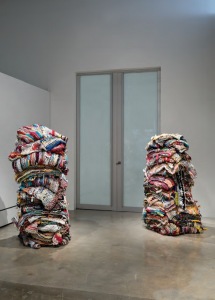
“Crochet Jam is about me. It’s about my wanting to create a community where I and others can embrace, tell stories, and share with each other without judgment, and not worry about what we’re making”
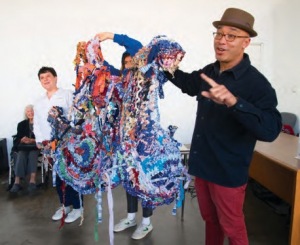

Sculptor and social practice artist Ramekon O’Arwisters has lived in the Bay Area since the early 1990’s, but he was born and raised in North Carolina. In 2012, his deep connection to African American craft traditions led him to develop the Crochet Jam, an experience of shared making using outsize crochet hooks and strips of recycled fabric that focuses on centering and relaxation. As O’Arwisters puts it, “Crochet Jam… engenders compassion and warmth. I want participants to be in a creative mindset without anyone dictating the creative process or worrying about the finished product. Crochet Jam is how I make liberation a form of art.” At the same time that hundreds of participants “jammed” with him across the United States, O’Arwisters has developed a unique studio practice, exhibition his work in galleries and museums and receiving wide recognition his his unique multimedia sculptures, including a spring 2020 project residency at Headlands Center for the Arts.
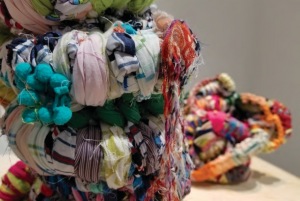
Maria Porges: Your gallery work combines crochet with fragments of ceramic in what I would describe as a “mending” relationship. How did you come to make these works, and how have they evolved?
Ramekon O’Arwisters: It started when I was at Recology, doing a residency in the fall of 2016. At first I was collecting a lot of stuff. It’s a residency at the San Francisco dump, so I found all sorts of things – new things, antiques, even a “tramp art” picture frame that someone had discarded. About 3 months in, Deborah Munk, the director of the AIR program, walked into my studio and said, “you know, you have a yard sale here…you have set aside a lot of stuff, and you have a show in a month. What is the concept? I went into panic mode, because she was right – a month isn’t a long time to organize a show that is going to get a lot of attention, which these residence shows usually do. I decided to reflect, step back, and see how I was feeling on the inside.
This was 2016, remember, and the election had taken place in the fall. I felt broken, detached, thrown away, sharp – so, I took those emotions and feelings, accepted them and thought, “Ok, we’ll have a whole new perspective on this. Instead of just looking at this as an opportunity to collect and accumulate, I’m going to look at it as a way of reflecting my emotions, and how they can be manifested in the material world. Whatever I’m feeling, maybe others are too.” I put on my protective gear and went into the recycling area. At first I saw the usual stuff that I wanted to drag to my studio. I thought, “this isn’t really working, I’m in the same frame of mind.” Suddenly I heard a crashing sound, four or five bins down from where I was standing. I trust my intuition at this point in my life – to protect me, to guide me. There’s a whole other world beneath the material world. I walked over and I was staring at broken ceramics.
Someone had cleared out the family heirlooms, or they just wanted to get rid of some stuff – plates, bowls, and teacups. I’m just standing there at the dump, looking at these broken, sharp things, and I’m misty-eyes. I remember thing, “I need medication, counseling, something.” But the I thought, “If I’m looking at shards and I’m emotional, it must be something in the unconscious I’m dealing with. They’re broken. And that’s how I feel.” I picked them up and brought them back to my studio, and I started making work. At first I put the shards in frames, but later, I thought, “Well, I’m also crocheting. What would it look like if I drew on my experience from the Recology residency and put together these two very different things that seem so incongruent – combine the practices I’d learned from my grandmother, sewing and crocheting, with something very hard, very brittle, that represents how I was feeling?” Everyone has a primal connection to shards. They are different from broken glass – a different emotional connection.

MP: Because ceramics is such an old part of culture.
RO: And because it’s earth that has been transformed from mud into something permanent. I wasn’t going to fix the broken pieces. I wanted to take the idea of recycling, of using remnants, that I’d grown up with – the purpose, the tradition of using everything – and bring that to ceramics as a stand-in for the human body. We’re vessels too. We have emotions, organs – we contain so much.
MP: When we talk about ceramics, we use the same vocabulary that we use to talk about the body – lip, neck, shoulder, belly.
RO: Yes, and intuitively, I knew that, though I’n not a potter. Eventually I moved from adding one or two shards to my fabric sculptures to incorporating as many as I could get in there without hurting myself. The closer you come in weaving the fabric together, the closer you come to the shard’s edges. After a few injuries, I figured out that I should slow down enough to wrap masking tape around the edges so I wouldn’t cut myself. Now I can wrap the fabric around the pieces completely.
In 2019, I stopped using found domestic pottery shards and started a collaboration with the ceramics department at California State University Long Beach. The faculty, staff and students there are making sculpture and one-of-a-kind tableware. Sometimes these pieces have mishaps, blowing up or breaking in the kiln, and they end up in the “shard yard.” I choose the ones I want from pictures, and they ship them to me.
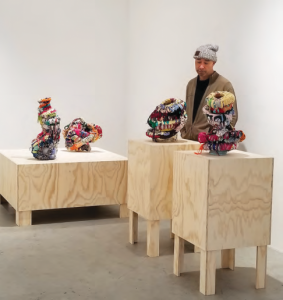
MP: You talk about crocheting around the ceramic pieces, but you do it with strips of fabric, rather than string or yarn. How did you get started working that way?
RO: Years ago, I would try to get my work into galleries here in San Francisco, but for about 15 years, there wasn’t much happening with my career. I was a painter. I thought, “There could be many factors that are out of my control.” I could have been angry, but anger is not redemptive unless you can learn something from it. I asked, “What am I angry about?” I realized that I wanted a community; I wanted to be embraced, to be heard, to be accepted on my own terms. So, instead of asking other people to give me that, I thought, “Why not dig deep and cultivate those attributes inside myself and give those things to others through the fold art tradition my grandma had taught me?” My mother, my grandmother, and my great-grandmother were all quilters.
I grew up Black and Queer in North Carolina, in the de facto segregated Jim Crow South of the ‘60’s and 70’s. It was a very homophobic environment. My grandmother, who was born in 1898 and lived to be almost 87, had seen quite a bit, and she understood who I was even before I did. One day, when I was very young – maybe eight or nine – she said to me, “Come here boy, and help me with this quilt. You can choose any color or pattern you want. An I’ll show you how to add it.” She already had a pattern; she’d been working on the quilt for months. But she was speaking to me in a symbolic way – the depth of her ability to do that was enormous.
MP: Because she was telling you that you could be yourself
RO: Yes. And I could do that in a safe environment. She couldn’t control what was going on outside the house the racism, the homophobia – but she could help me calm down, to feel accepted and embraced and then go out and find positive solutions. Because if I go out there, as hostile as the world is, I put my life in danger. That’s how Black Americans have been able to survive, and she understood that.
Rather than asking other people to accept me and my work, I decided to use the folk-art tradition that my grandmother had helped me to experience. That tradition had always been there in my life, but until I took the time to step back and reflect, I couldn’t see the tree for the forest. But those traditions – the way that I’d learned them from my grandmother – require needles; and working with the public, needles are inappropriate. I’d received a residency at the de Young Museum in San Francisco and the director loved my idea of bringing in folk art traditions and telling stories, but needles weren’t going to work. That pushed me to think outside of the box. I showed my work to one of my friends, and she said, “You’re braiding fabric and sewing the braids together to make rag rugs, but you can do. This with crocheting.” A light bulb went off. I designed some bigger crochet hooks, and when I got the Fleishhacker Foundation grant, I was able to use some of the funds to buy beautiful wood and commission a craftsman to make them for me. That allowed me to take crocheting to another level – to use fabric, on many levels – in a context that was healing, like my grandmother.
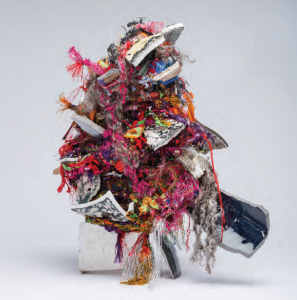
MP: Fabric is as old a material as ceramic. So, you were reaching back to something with whih every person has a relationship.
RO: That’s right – that’s very important to me. I needed to accept my journey as an artist – my journey, not a Western European journey, involving painting on canvas or working with marble in a specific fine art tradition; those things don’t speak to my experience. It’s like me trying to put myself in a context that doesn’t reflect the authenticity of my world. My grandmother, my mother – they both reflected their joy and pain through fabric. My father and mother worked at Hanes Knit, a cotton mill that’s since gone overseas. My father worked there with fabric for 35 years. We all have an unconscious relationship to fabric. I like that primary relationship to textiles, to ceramics. I like pushing ideas to the depths of their dream-like, symbolic language.
MP: Your newer pieces are made with some really extraordinary fabric; it’s more glittery and spectacular than in the previous work.
RO: The material I’m using in my current series, “Cheesecake,” consists o designer fabric remnants from New York and L.A. “Cheesecake” is a pejorative expression, in both gay and straight communities, for someone who is exotic, provocative, sensual. I saw it in RuPaul’s dictionary of phrases. I’ve been thinking about how I can make something that no one has ever seen before. This relates to how I feel as a Queer Black man – people see my race before my queerness, rather than seeing me as both at once.
MP: Your practice has both an outward-facing part – I see you traveling all over the country to do Crochet Jams, working with all kinds of people – and a part in which you make objects in the studio. How do these connect, and how are they different for you?
RO: To be honest, Crochet Jam is about me. It’s about my wanting to create a community where I and others can embrace, tell stories, and share with each other without judgment, and not worry about what we’re making. I suggest that people allow the material to inform them of what it wants to become. The result of the jam is a woven fabric z- you project on it what makes you feel comfortable.
MP: What do the participants get out of the experience of making?
RO: They have a lot of deep breaths – a lot of centering. I’m asking them to look at making differently – to make without a label, to allow themselves to just experience it. I ask them to accept what they are doing. Just to do it, not define it. I don’t want to be defined myself – politically, sexually, racially. We are more than our labels. I don’t expect the participants to go that far, but I want them to just choose their fabric and interact with it. They’re in a space where why aren’t being judged and they not being told what to do. I don’t give them instructions. I let go of my authority and allow them to maintain their agency.
MP: When you’re working in your studio, do you tell yourself the same thing?
RO: Absolutely. When I’m working, I hear a voice saying, “Don’t worry about how it looks,” and I think, “Who’s talking?” Then the voice says, “Accept it as it is.” This makes it possible to make things I haven’t seen before – in the context of I use fabric and ceramics.
MP: So, when you sit down to work, it’s without preconceptions?
RO: Yes, I just lay out the shards – after I tape their edges – and I look at them, the way that my grandma would look at colors and shapes and I improvise.
MP: The scale of your current studio work is relatively intimate, but I noticed that it’s getting bigger.
RO: During my residency at the Headlands, I’m planning to make work that, instead of looking down to see it, you have to look up and walk around it. Something that’s as big or bigger than we are, in which fabric doesn’t look like fabric anymore. I think about how water can be transformed to ice or steam. I’ve wondered how I as an artist could become so in tune with my materials that I could make them behave, make them appear like other materials. I want to know my material, my instrument, so well that I can improvise with it like a jazz musician. To become the conduit or what the material wants to become. All I have to do is just keep working. I wouldn’t be where I am now if I didn’t believe that.
MP: I’d like to talk about your name. In Japan, there’s a tradition of artists periodically taking new name to say something about themselves. For instance, when Hokusai was in his 80’s, the last name he took was “old man mad about drawing.” Is Ramekon O’Arwisters a “taken” name?
RO: It’s a name that I needed, to be who I wanted to become. My birth name came out fo the Judeo-Christian tradition. No one expects much from a name that’s so common – Timothy and I needed a name that would change my posture, that would put me in the world with confidence, in opposition to that heritage. My father, whose name was Arwistus, never mistreated me for being a gay child. Some men would have been embarrassed by my ways, my voice. As I got older, my dad never minded when I brought my boyfriends home. He would even show them around town. In the Black Church, the whole idea of gay and lesbian culture is still very unaccepted. I took his name to remind me to have that kind of compassion. I added the “O” which in the Celtic tradition means “child of”. As for my first name, I think that the work “ramekin” – the cooking dish – is beautiful. But I know that if I spelled it that way it would confuse people, so I changed the spelling. You can’t dismiss it – it’s powerful. Ramekon.
It’s through my work that I can be that person – be the most authentic, the most honest. It is very important to me that I am able to accept my journey as I am. Every day, I’m working with rags and broken ceramics. And when people look at my work and they see the sharp angles and pieces – they see that the shards aren’t being thrown away – we’re going to keep you here.” By extension, we all feel broken sometimes. We want people to mend us, hold us in their embrace. Come visit us when we’re not feeling well, write a note. Hold our hands. Hear, without interrupting actually listen. It’s a gift to be heard. I do the best job I can.
